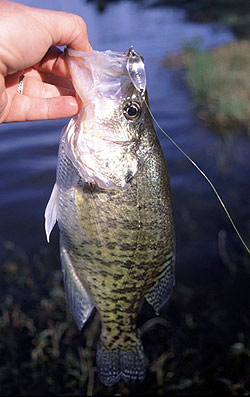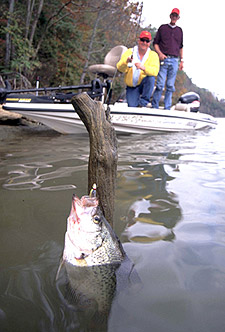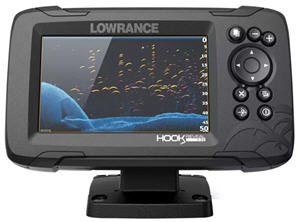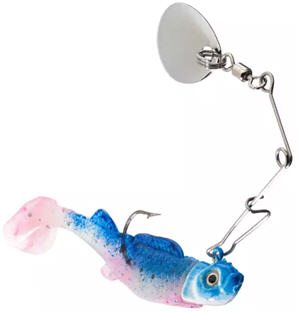
"It's only easy when it's easy. And most times, it's not that easy."
My uncle used to say that about crappie fishing. It was his way of telling me not to get discouraged when things got tough.

"Some days, you can't do anything wrong," he'd say. "Anywhere you fish, you'll catch a crappie. More often than not, though; fishing conditions are less than perfect, and you'll have to dig down in your bag of tricks to find something that works."
More than 30 years have passed since my uncle taught me the basics of crappie fishing. During that time, I've learned there's no magic formula to ensure success. But if you know how crappie are likely to behave during unfavorable conditions, you can tip the odds in your favor.
Let's look at some tips offered by expert anglers. They can help you catch crappie when things get tough.
A Look at Some Crappie Fishing Problems & Solutions
Problem: The lake you're fishing is extremely muddy. On a scale of 1 to 10, fishing hardly rates a 4.
Solution: Steve Filipek, a fisheries biologist with the Arkansas Game & Fish Commission, has tackled muddy-water conditions often during a lifetime of crappie fishing.
"When fishing muddy water, I look for places where water is less turbid — up in creeks, the backs of coves, around green vegetation, places like that," he says. "Crappie are sight feeders, and the slightest bit of clearer water improves the chance they'll see your bait."
"Crappie hold tighter to cover when water's muddy," Filipek reports. "Most of us fish an area quickly, then move to the next spot. In muddy water, work slow. Cover 360 degrees around that stump or treetop. Work your bait close to the cover, and be thorough."
Problem: Your crappie lake is clear. Crappie seem spooky, and you've caught few fish.
Solution: Steve Wunderle of Cartersville, Illinois, wrote the book "New Techniques That Catch More Crappie". He often encounters clear water on Illinois' Crab Orchard Lake.

"When fishing clear water, go to light line," says Wunderle. It's more difficult for crappie to detect. I use eight-pound line in stained water, but in clear, I drop to six or four. Think small in clear water — light fishing line, light float, small fishing jigs and lures.
"To avoid spooking fish," Wunderle continues, "back off some and cast your jigs. I use a float with a light jig, cast past the cover and gently jig it back or let the wind carry it over the top."
Problem: After heavy rainfall, the lake is rising fast. New cover is flooded, and fishing your favorite brushpiles and treetops is unproductive.
Solution: Steve McCadams of Paris, Tenn., is a crappie guide on Kentucky Lake. He sometimes encounters fast-rising water after spring rains.

— use a graph to find the bushpile."
"A fast rise scatters fish," says McCadams. They don't stay concentrated and holding around cover. Most are suspended and moving like nomads.
"Spider-rigging lets you cover more water, and that's what you must do to locate scattered fish during a fast rise. Rig your poles with different color jigs set at different depths, then troll slowly, making large zigzagging sweeps. Troll over structure going to and from spawning areas. If you're patient and cover lots of water, sooner or later you'll catch fish."
Problem: Spring rains ended, and water is falling fast. You've fished shoreline areas that produced crappie last week, but now they've vanished. Nothing seems to work.
Solution: Bill Peace of Jonesboro, Arkansas, often encounters fast-falling water on oxbows lakes he fishes.
"Most oxbows flood each spring," Peace says, "then the water drops quickly until conditions stabilize. When this happens, crappie leave shallow water. Their instinct tells them to move to deeper water until everything settles. Most are suspended, holding tight to cover in the lake's midsection."
"These crappie are persnickety," Peace continues. "You must fish slow, working each bit of cover thoroughly. Drop to smaller jigs. Instead of 1/32-ounce, drop to 1/48th or even 1/64th. These lures fall slower, enticing finicky fish."
Problem: A storm front hits. Wind picks up, and it starts raining. Abruptly, crappie quit biting.
Solution: W.T. Moore of Mountain View, Arkansas, has been an avid crappie angler decades. It's not unusual, he says, to get caught in a sudden rainstorm.
"Safety first," Moore says emphatically. "If there's lightning or high waves, leave immediately. If it's safe to stay, you'll probably find crappie in the thickest cover available — buckbrush, willow thickets, etc. Position your boat so the wind blows you against the cover. Use a long pole to work a jig into the brush, then fish little pockets most folks miss. Work the jig with a slow bounce, and work each hole thoroughly."
Fishing is toughest after fronts pass. "Don't be discouraged, though," Moore notes. "Work each pocket carefully, and you'll continue catching crappie."
Problem: It's that "in-between" time. The worst of winter is behind, but warm spring days are several weeks away. One day crappie are shallow; the next they're deep. What should you do?
Solution: Ray Deering of Ashdown, Ark., lives by Lake Millwood, one of the South's premier crappie lakes. His observations of Millwood crappie apply to many large, shallow lakes.
"As water warms toward 62 degrees, crappie prepare to find their spawning beds," says Deering. "First, they move from the main river channel up on the dropoffs. That's where you want to start fishing. When they leave deep water for shallows along the bank, start fishing shallow. Unfortunately, before actual spawning begins, they may move between shallow and deep water several times as weather changes. Smart fishermen move back and forth with them."

"With a fishfinder, I can find channels,
dropoffs, brushpiles or whatever."
Deering locates pre-spawn crappie using a fishfinder with sonar. "With a depth-finder, I can find channels, dropoffs, brushpiles or whatever," he says. "Without it, I'd have a hard time finding crappie."
Problem: You tried your six favorite jig colors but crappie refused the offerings. Is it time to give up?
Solution: Harold Robbins ran the boat dock on Lake Overcup near Morrilton, Ark. When I arrived at the dock empty-handed one afternoon, he chided me for giving up too soon.
"A guy was through here an hour ago that took 20 big slabs on a pink-and-white jig. Did you try that color?" he asked.
"No," I replied.
"You should have stopped and asked before you went fishing," he said. "I recommended it to him this morning, 'cause a guy was catching crappie on that color yesterday."
"Always check at the bait shop to find out what's been working best," he continued. "We interrogate every angler coming through here, and ask what they're using, what depth they're catching fish, and where. We don't keep anything secret. We want everyone to have an enjoyable fishing trip."
Problem: The fish are there; your sonar unit indicates as much. But they refuse to bite. What now?
Solution: "Most crappie anglers use jigs or minnows and nothing else," says Lewis Peeler, an ardent crappier from Wynne, Ark. "I've seen times, though, when other baits worked, and jigs and minnows didn't. On some lakes I've fished in Louisiana, we caught more crappie on freshwater shrimp. Crappie in ponds near my home seem to hit small spinners or spoons better than jigs or minnows. On certain lakes at certain times of the year, I catch most crappie using small shad-imitation crankbaits."
"The key," he continues, "is versatility. If one bait or lure or color doesn't work, be prepared to try something different."
Problem: Crappie are hitting so lightly, their bites go undetected. How can this problem be overcome?

hit small spinners or spoons better than
jigs or minnows."Bass Pro Shops Crappie
Maxx Paddle Tail Minnow Spin
Solution: "It pays to be a line watcher," says Jim Spencer, an outdoor writer from Calico Rock, Ark. "A crappie may rush a bait, then just flare its gills and inhale it. The only indication of a bite may be a slight slackening of your line or a tiny, almost imperceptible twitch. You must be watching to see it and react."
"When using a bobber," he continues, "be sure it's not too large. A bobber the size of a grape detects strikes better than one the size of a golf ball."
Problem: Your crappie lake has dozens of sunken brushpiles to attract crappie, but you can't hook anything but snags.
Solution: Bill Fletcher of Mountain Home, Arkansas, has guided fishermen on Lake Norfork for more than 20 years. He was instrumental in the completion of the Lake Norfork fish cover project.
"Brushpiles are magnets for crappie," he says. "Use a graph to find the brushpile, and mark it with a buoy. Then take your boat a cast away from your buoy, and using 4-pound-test line and a 1/16-ounce jig head, cast to the buoy. Count the jig down until you get a strike or hit brush. If you get a strike, use the same count next cast. If you hit brush, use a shorter count.
"The key to catching crappie on fish attractors is positive depth control," Fletcher continues. "Crappie don't feed down, they bite up. So don't fish under them. You establish that the fish are at a certain depth, then boom, boom, boom, you're putting them in the boat."
The next time you confront a tough situation, try the tips offered by these expert crappie anglers. They won't pay off every time, but they will pay off most of the time. And that means more crappie fishing fun for you.
- 26557 views

